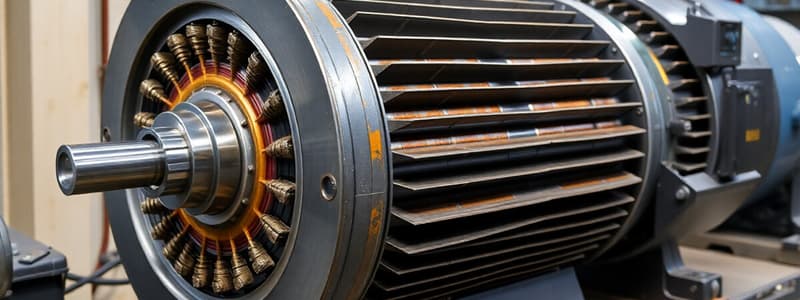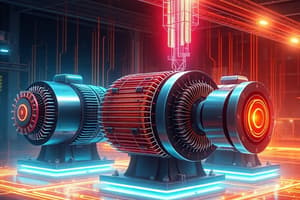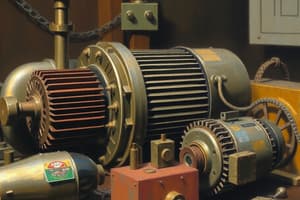Podcast
Questions and Answers
What is the formula used to calculate the electrical power input (Pin) for a three-phase induction motor?
What is the formula used to calculate the electrical power input (Pin) for a three-phase induction motor?
- $P_{in} = \frac{2\pi n T}{60}$
- $P_{in} = V_{1} \times I_{1}$
- $P_{in} = \sqrt{3} \times V_{1} \times I_{1} \times \lambda \times P.f$ (correct)
- $P_{in} = \frac{P_{out}}{\eta}$
Why does an induction motor require rotor current on no-load operation?
Why does an induction motor require rotor current on no-load operation?
- To provide sufficient torque for overcoming load friction
- To overcome bearing and windage friction (correct)
- To reduce losses in the electrical conversion process
- To maintain constant stator current regardless of rotor speed
What happens to rotor current as the load on an induction motor increases?
What happens to rotor current as the load on an induction motor increases?
- Rotor current increases to meet the demand for greater torque (correct)
- Rotor current instantly drops to zero
- Rotor current remains constant regardless of load
- Rotor current decreases to maintain efficiency
What does the term 'slip' refer to in an induction motor?
What does the term 'slip' refer to in an induction motor?
When calculating motor efficiency (η), what does the ratio Pout / Pin represent?
When calculating motor efficiency (η), what does the ratio Pout / Pin represent?
What are the three components of current drawn by the stator on load?
What are the three components of current drawn by the stator on load?
What is required to maintain during a load test on an induction motor?
What is required to maintain during a load test on an induction motor?
How is the output of the motor calculated when using a mechanical brake during a load test?
How is the output of the motor calculated when using a mechanical brake during a load test?
Which factor is typically measured to determine the efficiency of an induction motor during a load test?
Which factor is typically measured to determine the efficiency of an induction motor during a load test?
What is a common cause of low power factor in distribution systems?
What is a common cause of low power factor in distribution systems?
Flashcards are hidden until you start studying
Study Notes
Induction Motor Rating and Efficiency
- Motor power is rated in terms of mechanical output power.
- Electrical power input is determined by: √3 x V₁ x I₁ x λ x P.f, using line voltage (V₁), line current (I₁), power factor (λ).
- Mechanical power output is determined by: 2πnT / 60 using rotor speed (n) in rpm and motor torque (T) in Nm.
- Motor efficiency is the ratio of output power to input power: η% = (Pout / Pin) x 100.
- Output power is always less than input power due to losses in energy conversion.
Effect of Rotor Current on Stator Current
- Rotor current increases with increased load, leading to greater torque demand.
- Increased rotor current has a corresponding opposite change in stator current.
- Stator current has three components: magnetising current, iron-loss current, and current to balance the rotor mmf.
Induction Motor Operation
- No-load: Energy is used to establish the rotating magnetic field and overcome motor losses.
- With load: Energy is used to establish the rotating magnetic field, overcome motor losses, and drive the load.
- Stator current on load is the phasor sum of magnetising (Iμ), iron-loss (In), and load components.
Induction Motor Load Test
- A load test determines motor performance at different loads.
- Constant supply voltage and frequency are crucial for accurate results.
- Load can be applied using a direct-coupled generator or a brake.
- Quantities measured include: speed, rotor current (slip-ring motors only), stator current, power factor, power input, efficiency, and power output.
- Stator and rotor currents measured are line values.
Induction Motor Load Characteristics
- Speed: Falls fairly uniformly as power output increases.
- Rotor current: Rises almost uniformly with increased load, increasing the torque component.
- Stator current: Increases proportionally to rotor current, as it neutralizes the rotor mmf.
- Power factor: Improves with increased load, as the stator current becomes more in phase with the applied voltage.
- Power input: Increases with load, reflecting increased energy conversion.
- Efficiency: Increases to a maximum at full-load, then decreases under overload conditions.
Effects of Reduced Voltage
- Reduced voltage significantly impacts motor performance:
- Reduced rotating magnetic field strength.
- Reduced induced voltages and currents in the rotor.
- Reduced torque output, proportional to the square of the applied voltage.
- Reduced voltage increases the supply current, potentially stalls the motor, and prolongs the acceleration period.
Representative Efficiencies and Power Factors
- This table provides efficiency and power factor values for various synchronous speeds, pole numbers, and motor sizes.
Study Points
- The motor's drooping speed characteristic is a result of the speed adjusting to the required torque.
- The power factor improvement with load is due to the increased load component of stator current, reducing the lag.
- The efficiency curve reaches a maximum at full-load, where variable copper losses roughly equal constant losses.
- Reduced voltage significantly reduces torque due to the squared relationship between voltage and torque.
Studying That Suits You
Use AI to generate personalized quizzes and flashcards to suit your learning preferences.





